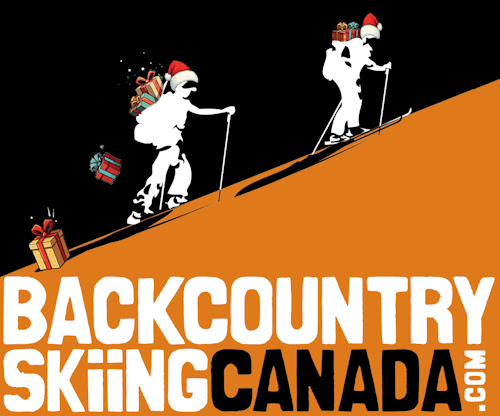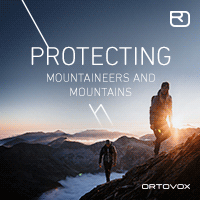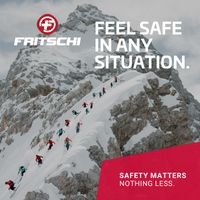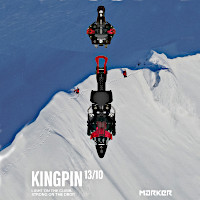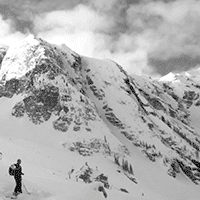New styles of ski development in Northern BC
Ski unique:New styles of ski development in Northern BC
These days, there just isn’t as much money as there used to be to maintain recreation opportunities for those living in northern BC, especially when it comes to a sport like skiing, often portrayed as a pastime only the Whistler set can afford to do right.
Ski hills around the province are battling declining client numbers, lower incomes and rising costs of running remote operations, and those in the Northwest are not escaping the struggle. However, two particular ski areas are also attracting the creativity and ingenuity of their patrons, who are hoping to craft sustainable and affordable recreational resources for their communities.
Hankin-Evelyn
The conception and development of the Hankin-Evelyn Recreational Area, which lies about 40 minutes north of Smithers along the Kitseguecla Lake Road, sprang from the passion of community members hoping to nurture winter sport in their region. Although nearby Hudson Bay Mountain boasts tons of prime ski estate, Brian Hall, a backcountry skier, had for years kept his eyes open for an undeveloped area of Crown land with a northeast aspect and reasonably close to town. He hoped it would provide excellent backcountry skiing without having to go all the way up into the alpine.
“There’s not a lot of protected tree-skiing in the area,” says Hall. “There’s lots of alpine ski-touring opportunity around, but much of it is difficult to access or on difficult terrain.” He believed that with some judicious pruning and run-shaping, a recreational area could be created that would become an asset to the entire Bulkley Valley.
When a friend alerted him to money available through the provincial government’s Job Opportunities Program (JOP), Hall recognized that the means for realizing a decades-old ambition could be within reach. As part of BC’s Community Development Trust program,JOP funding specifically targets organizations working within resource-dependent communities. Hall and friend Jay Gilden approached Wayne Buholzer, President of the Bulkley Valley Backpackers Society, about submitting an application through that non-profit society.
“It was an area where there were some trails already,” says Buholzer, who saw a great opportunity to develop more trails, as well as renovate an old fire lookout run by the society as a cabin.
That application was ultimately successful, garnering the BVBS more than $408,000. Pro-Tech Forests, a natural-resources consulting firm, was retained to manage the project, hiring laid-off forestry workers and putting them into action on the summer slopes where winter ski-tourers would eventually benefit. “The whole project was geared towards putting money back into various economies,” says Hall.
Eight runs, connector trails, up-tracks and a couple of valley-bottom loops have been clipped into the mountainside so far, and Hall ardently hopes that the Hankin-Evelyn range can over the years become home to a comprehensive network of hiking trails and ski and snowshoeing areas. “One of our goals is to create terrain that will appeal to a wide range of people,” he says, “giving them a healthy option for recreation that is relatively inexpensive.” More funding will eventually be sought to improve the access road and build a day-use shelter where hikers and skiers can gather.
Self-propelled
What makes the new backcountry ski area appealing is the fact that it’s easily accessed by road, but once that truck is parked, travel through the wilderness area is foot-powered only. “This area is designated non-motorized,” Hall emphasizes; “There won’t be any lifts, no real-estate developments, no hot-dog stands. It’s purely for self-propelled sports.”
This means skiers in search of fresh tracks will be well rewarded on powder days, as the number of visitors willing to earn their turns will be naturally lower than at the lift-assisted resort on Hudson Bay Mountain. As of late December, Hall noted that local skiers seemed already to be enthusiastically embracing the area in its first winter, despite the need for more snow to really blanket the runs.
Hall and Buholzer believe that a range of options for winter leisure activities can only enrich the region, and hope the Hankin-Evelyn backcountry area comes to be recognized by all as part of what attracts winter tourist dollars to the Bulkley Valley. “There are options for skiing here now: we have cross-country, the down-hill area, and now this backcountry area,” says Hall, suggesting that the short-term economic benefits from theJOP funding for the project’s start-up will translate into long-term economic gain for local businesses.
While big resorts around the province are facing uncertain futures, snow-lovers in the Northwest now have a new playground to explore, one that costs only sweat and muscle to access, and very little to maintain.
Meanwhile, back at Shames…
Despite all the accolades of epic powder and world-class terrain, Shames Mountain near Terrace is struggling. The mountain’s visitors hail mainly from the local areas of Terrace, Prince Rupert, and Kitimat, three communities that have all lost major resource-based employers in the last several years. Other factors, including the costs of doing business in an isolated location, are taking their toll, too. Located a half-hour drive from Terrace, Shames is not connected to the hydro grid; the chairlift is powered by generators burning costly diesel fuel.
To a large extent, the Shames Mountain Ski Corporation has only managed to stay open through the dedication and largesse of the current owners, who have continued to fund the operation from their own pockets. Despite these dire-sounding facts, however, skier visits have not declined appreciably; northern powder aficionados are still steadily purchasing passes; and the average annual snowfall of 1,200 cm (which blows away Whistler’s average of 900 cm) continues to fall. Unlike Whistler, however, Shames’ global profile is virtually invisible—even though ski publications such as Powder Magazine consistently compliment the sheer amount of snow and the quality of the terrain.
After nearly 20 years, the resort’s current owners are looking for fresh energy to take over operations: Shames has been listed for sale for about $1.5 million for nearly two years and is in need of a healthy cash infusion to upgrade its infrastructure. Although several overtures of commercial interest have been acknowledged over the last couple years, including a proposal to use it as an exclusive members’ facility, Shames’ directors have repeatedly stressed that they would most like to see the hill maintained in the best interests of the local community.
The Shames Mountain Co-op
In recent months two groups have come into existence with similar ideas for the future of the Shames Mountain ski area. The Shames Mountain Coop was formed by two Americans living in Argentina, Jamie Schectman and his wife Shanie Matthews, who were emailed the online listing for Shames by a friend. Disgruntled with their local ski resort after a poor day of service, Schectman and Matthews were struck by the concept of organizing a for-the-skiers, by-the-skiers co-operative to purchase and operate Shames. Through the social-networking power of the Internet, Schectman was able to contact Shames’ ski enthusiasts to gauge whether the idea was worth pursuing. Several people from Terrace and Prince Rupert formed a group called Friends of Shames to garner community involvement, and by early September 2009, hundreds of users had signed up and were busily posting on the forum begun by Schectman and Matthews to investigate the taste for and viability of a Shames ski-area co-op.
The co-operative business model should be a familiar one to Canadian outdoor enthusiasts; the popular outdoor equipment retailer Mountain Equipment Co-op has a collectively owned, democratic business structure where product development and service is for the members, by the members.
As it stands now, the Shames Mountain Co-op (SMC) bills itself as a “grass-roots, forward-thinking movement” that plans to sell shares to interested skiers, snowboarders and investors looking to be part of a business that pays attention to more than just the bottom line. Schectman, a long-time backcountry skier and business entrepreneur, is adamant that although shareholders will begin to receive dividends a few years after start-up, all business decisions will be made with three core elements in mind: the local community, the environment, and the guests that come to enjoy the mountain. “If you do things that are value-based,” asserts Schectman, “the profits will come.” He hopes that people will be willing to give their business to an organization that strives to give something back.
By pursuing the for-profit co-op model, Schectman and Matthews hope to attract a hitherto untapped international base of investors. “As far as I know, there’s never been any marketing outside of northwest BC,” says Schectman. “It’s safe to say that if people buy a share they’re going to want to visit and talk up their product.” Schectman believes that being able to access global shareholders’ information, expertise—and, of course, money—will be vital in an uncertain economic climate, not to mention an economically challenged region.
Friends of Shames
SMC is not the only potential co-op on Shames’ powdery horizon, however. Friends of Shames (FoS) served official notice of their break with Schectman in November when that original group of skiers and business-owners felt that all options should be more thoroughly explored before fixing on one particular model. FoS calls itself a steering committee, aiming towards the “strongest, most effective business model for ensuring the long-term viability of Shames Mountain Ski Area,” according to spokesperson Mary Bartlett.
After four months of consultations and many hours of donated professional time, FoS has decided to pursue a locally focused community service co-op model, which blends the benefits of a co-operative with those of a non-profit society. “You have ownership through member shares in addition to sourcing capital through public funding,” says Bartlett. “By falling under a non-profit designation, you’re eligible for tax breaks.” FoS sees great opportunity for government grants in the areas of greening and tourism: “Those are two areas where the money isn’t so dry,” says Bartlett.
Gerry Martin, media spokesperson for Shames Mountain Ski Corporation, agrees that the advantage seems to be with the non-profit model. “Take Mount Timothy: they received a million dollars through Northern Development Initiative Trust this year.” Mount Timothy Ski Area, south of Williams Lake, operates as a non-profit society and has been in operation for 21 years.
Although initially Schectman and Matthews appeared to be allied with the Friends of Shames, differences in opinion over whether to go global and for-profit have divided the two groups. Schectman says SMC is currently in limbo, awaiting expressions of interest from Shames locals before moving forward. Bartlett, on the other hand, says that FoS feels confident about the solid base of due diligence completed thus far and is raising money for a feasibility study.
Both groups agree that Shames is an invaluable community resource. A ski hill that has captured imaginations half a world away has just as strong a hold on the people who can’t wait for the snow to hit the mountain’s slopes each year. Although any concrete development may take time, recent emergence of beyond-the-boundary thinking about Shames’ future can only be a good thing.
For information on the Hankin-Evelyn Recreational Area visithttp://www.bcnorth.ca/bvbackpackers; a map of the area is available there.
For more information on the Shames Mountain Co-op, visit http://www.shamesmtncoop.com
To reach the Friends of Shames, email [email protected]
